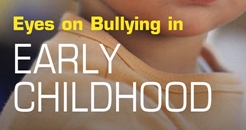 Bullying insights
Bullying insights
From a report by PromotePrevent
Bullying is a repeated aggressive behavior where one person (or group of people) in a position of power deliberately intimidates, abuses, or coerces an individual with the intention to hurt that person physically or emotionally. Acts of bullying can be physical or verbal.
Many young people can be unkind to each other during adolescence as they refine social skills and grow into adults. While these interactions are unpleasant, there is a clear line between conflict and bullying. Incidents of bullying must include all 3 of these characteristics:
1) Intentional- the behavior was aggressive and a deliberate attempt to hurt another person
2) Repeated- these aggressive actions occur repeatedly over time to the same person or group of people
3) Power imbalance- the person bullying has more physical or social power than the child or children being bullied
Bullying almost always takes an emotional toll upon the child being bullied, but the actions that constitute bullying vary. There are four types of bullying, which can occur separately or simultaneously:
1) Physical bullying such as kicking or pushing
2) Verbal bullying such as name-calling or yelling
3) Relational bullying such as excluding or rumor-spreading
4) Cyberbullying which involves sending hurtful messages over digital devices like computers and cell phones.
Cyberbullying continues to increase as digital media become more prevalent in the social culture of children and teens.
Situations involving bullying are often more complex than they seem. Three widely recognized roles in bullying situations are victim, bully, and bystander. However, bullying situations are rarely simple. Youth who are victims of bullying may also act as bullies under some circumstances.
Be cautious about labeling. While we use the terms “victim,” “bully,” and “bystander” to refer to the roles that youth can play, it is important to consider the impact that these labels can have on young people’s identities. Many researchers and educators believe that such labeling sends a message that the bullying behavior cannot change. There are many factors that might influence a youth’s behaviour, such as the youth’s peers, family situation, and school climate. While we use the terms victim, bully, and bystander throughout this site for simplicity, we believe it is better to focus on the bullying behaviors, rather than the labels.
The effects of bullying involve both the bully and the victim. Youth who are bullied are more likely to suffer from the following:
-
Depression, anxiety, eating disorders, and thoughts of suicide
-
Health issues like headaches, sleep problems, abdominal pain, bed-wedding, and fatigue
-
Academic issues including poor attendance, low test scores, and increased dropout rates
Youth who bully:
-
Are at greater risk of smoking tobacco and drinking alcohol
-
Perform poorly in school and have a poor perception of school environment
-
Are more likely to become involved in criminal activity and to experience psychiatric disorders
Bullying can emerge in early childhood. Children as young as age 3 can and do participate in bullying in early childhood settings, such as daycare, preschool, home care groups, play groups, and kindergarten classrooms. Early childhood settings provide an opportunity for educators to effectively prevent and stop the emergence of bullying behaviour and to foster the development of positive social interactions.
Download a report about Preventing Bullying In Early Childhood here.
Retweet about this article:
From a report by PromotePrevent, 21/02/2018